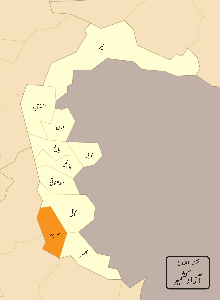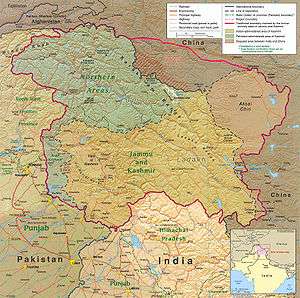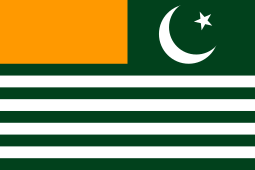Mirpur District
| Mirpur ضلع میر پور | ||
|---|---|---|
| district | ||
| ||
| Coordinates: 33°08′57″N 73°45′12″E / 33.1491°N 73.7534°ECoordinates: 33°08′57″N 73°45′12″E / 33.1491°N 73.7534°E | ||
| Country | Pakistan | |
| Established | 1947 | |
| Headquarters | Mirpur | |
| Area | ||
| • Total | 1,010 km2 (390 sq mi) | |
| Population (2017) | ||
| • Total | 456,200 | |
| • Density | 452/km2 (1,170/sq mi) | |
| Time zone | UTC+5 (PST) | |
Mirpur district (ضلع میر پور) is a district in Azad Kashmir.[1] The district is named after the main city, Mirpur. The district of Mirpur has a population of 456,200[2] and covers an area of 1,010 km2 (390 sq mi). The district is mainly mountainous with some plains. Its hot, dry climate and other geographical conditions closely resemble those of Jhelum and Gujrat, the adjoining districts of Pakistan.
History
During the British colonial times, Mirpur was one of the five districts of the Jammu province in the princely state of Jammu and Kashmir.[3][4] It consisted of three tehsils: Kotli, Mirpur and Bhimber.[5] Kotli and Bhimber have since been made into separate districts. According to the 1941 census, the original district had a population of 386,655, roughly 80% of whom were Muslim and 16% were Hindu.[6] The Mirpur district, along with the districts of Poonch and Rajouri, had close geographic, ethnic and cultural connections with West Punjab, more so than with the Jammu city and the rest of the Jammu province. The people of Mirpur therefore had a strong desire to join Pakistan.[7]
Language and ethnicity
There is considerable ambiguity surrounding the name of the local language:[8] its speakers call it variously Pahari, Mirpur Pahari, Mirpuri and Pothwari,[9] while some label it as Punjabi.[10] Sociolinguists have regarded it as one of the three major dialects of the Pahari-Pothwari language complex,[11] which is intermediate between Lahnda and Punjabi.[12] Mirpur Pahari is mutually intelligible with the other two major dialects – Pothwari of the Potohar Plateau in Punjab and the Pahari spoken to the north in Azad Kashmir and around Murree – and shares with them between 77 and 84% of its basic vocabulary,[13] although the difference with the northernmost varieties (in Muzaffarabad) is sufficient to impede understanding.[14] Mirpuri speakers have a strong sense of Kashmiri identity that takes precedence over linguistic identification with closely related groups outside of Azad Kashmir.[15]
Another language spoken here is Gujari. The local dialect is closely related to the Gujari varieties spoken in the rest of Azad Kashmir and in Hazara.[16] Other languages spoken include Urdu and English.
The vast majority of the district's population belong to the Jatt ethnic group followed by Rajputs and Gujjars. The rest were lower caste people known as massalis up to the 1950s.[17] They included artisans like nais, chamars, mochis, telis and others. These groups eventually left their massalin Mirpuri Potohari; the Majh and Gojri dialects of Punjabi Language are now the predominant languages of the district.
Government


The district is administratively subdivided into 3 Tehsils:
Tourism
- Islamgarh (town)
Located 30 km from Mirpur - comes between Chaksawari and Kakra. Its distance will be 7 km after completed of Rathoa Haryam Bridge
- Kakra (town) - Located 12 km from Mirpur - comes between Mirpur and Islamgarh.
- Khari Sharif - located 8 km from Mirpur; it
is famous for its Sufi shrines.
- Mangla, a town 16 km from Mirpur; it is situated at the mouth of the Mangla Dam.
- Rajoa
- Ramkot Fort
- Sahalia
Education
District Mirpur stands at number 12 nationally in the ranking related to education with an education score of 72.16, according to Pakistan district education ranking 2017, a report by Alif Ailaan.
The learning score is at 80.94 and gender parity score of 84.26. Retention score is low at 51.27. The reason for low retention score is that the number of schools which cater to beyond primary are far less than primary schools.
When it comes to infrastructure, Mirpur ranks at 102, with school infrastructure score of 36.25 which is low and shows how poor the buildings and furniture are in schools. Availability of basic facilities such as electricity and functional toilets are also a major source of concern. Access to schools is also a major area of concern. For more detailed scores visit TaleemDo! App
Media
Media of Mirpur district is evolving day by day and a number of the media company are taking interest in Mirpur and launching their newspaper as Mirpur edition Daily Mahasib started its journey in February 2006 other newspaper also launched their Mirpur edition like daily Adalat, daily Shaheen, Daily Kashmir express. they all provide daily Mirpur news, International news, national news, political news, sports, entertainment, showbiz, commerce, business news.
Refugees
Erstwhile Mirpur District (including present-day Bhimber District) has a considerable refugee population (like refugees in Karachi) They are from almost all the castes; however, Mirpur (especially Tehsil Dadyal) has predominantly Jat and Gujjar caste refugees. The villages of Jat refugees in Tehsil Dadyal are Mohra Kanyal, Malkan and Mehndir Colony. A vast majority from Mohra Malkan has shifted to Village Khairowal Jattan, Tehsil Barnala, Distt Bhimber in 1974 where each family was allotted 64 Kanals of agricultural land. However, many of the families which shifted to Khairowal or Chamb still have nostaligic feelings of their days in Dadyal and great people of Dadyal. They do not miss an opportunity (funeral, weddings, festivals) to enjoy their occasional reunions with the inhabitants of Mohra Malkan and other nearby villages like Chapran, Mehra etc.
Villages
- Mirpur tehsil
Afzalpur, Abdulahpur, Andrah Kalan, Arah Jagir, Ballah, Pakhral, Banni, Bongdawara, Burjan, Chabrian Dattan, Chak Haryam, Chakswari, Chandral, Chak Sagar, Chatan, Chechian, Chitterpari, Dalyala, Dheri Thothal, Rathoa, Ghaseetpur Awan, Ghaseetpur Sohalian, Islamgarh, Mora Rakhyal Mora Loharan, Mora Rathyan, Mankarah, New City', Tariq Abad„ Jatlan, Jangian Kotla, Kakra, Kalyal Bhainsi, Kas Kalyal, Khari Sharif, Khokhar, Mehmunpur, Mori, Nagial, Pindi Subherwal, Potha Bainsi, Sahang, Saleemabad, SukhChainPur, Nawan Garan, Gorsian, Chak Ghayan, Raipur.
- Dadyal tehsil
Amb, Chattroh, Haveli Baghal, Kathar Dilawar, Mandi, Mohra Malkan, Mohra Sher Shah, Rajoa, Ratta, Sahalia, Siakh Pahaith, Thalarajwali Khan, Thub Jagir, Ankar Raajgan.
References
- ↑ - Government Website
- ↑ "Census 2017: AJK population rises to over 4m". The Nation. Retrieved 2017-09-01.
- ↑ Karim, Kashmir The Troubled Frontiers 2013, pp. 29-32.
- ↑ Behera, Demystifying Kashmir 2007, p. 15.
- ↑ Snedden 2001, p. 112.
- ↑ Snedden 2001, p. 118.
- ↑ Snedden 2001, p. 120.
- ↑ Lothers & Lothers 2010, p. 100.
- ↑ Lothers & Lothers 2010, pp. 2–3, 5, 19, 100.
- ↑ Lothers & Lothers 2010, p. 44.
- ↑ Lothers & Lothers 2010, p. 2.
- ↑ Shackle 1979, p. 201.
- ↑ Lothers & Lothers 2010, pp. 2, 24.
- ↑ Lothers & Lothers 2010, p. 86.
- ↑ Shackle 2007, p. 114.
- ↑ Hallberg & O'Leary 1992, pp. 111–12. The variety surveyed is from Kotli, to the north of Mirpur District
- ↑ Pakistan's caste system: The untouchable's struggle, The Express Tribune, 31 March 2012.
Bibliography
- Behera, Navnita Chadha (2007), Demystifying Kashmir, Pearson Education India, ISBN 8131708462
- Hallberg, Calinda E.; O'Leary, Clare F. (1992). "Dialect Variation and Multilingualism among Gujars of Pakistan". In O'Leary, Clare F.; Rensch, Calvin R.; Hallberg, Calinda E. Hindko and Gujari. Sociolinguistic Survey of Northern Pakistan. Islamabad: National Institute of Pakistan Studies, Quaid-i-Azam University and Summer Institute of Linguistics. pp. 91–196. ISBN 969-8023-13-5.
- Karim, Maj Gen Afsir (2013), Kashmir The Troubled Frontiers, Lancer Publishers LLC, pp. 29–32, ISBN 978-1-935501-76-3
- Lothers, Michael; Lothers, Laura (2010). Pahari and Pothwari: a sociolinguistic survey (Report). SIL Electronic Survey Reports. 2010-012.
- Shackle, Christopher (1979). "Problems of classification in Pakistan Panjab". Transactions of the Philological Society. 77 (1): 191–210. doi:10.1111/j.1467-968X.1979.tb00857.x. ISSN 0079-1636.
- Shackle, Christopher (2007). "Pakistan". In Simpson, Andrew. Language and national identity in Asia. Oxford linguistics Y. Oxford University Press. ISBN 978-0-19-922648-1.
- Snedden, Christopher (2001), "What happened to Muslims in Jammu? Local identity, '"the massacre" of 1947' and the roots of the 'Kashmir problem'", South Asia: Journal of South Asian Studies, 24 (2): 111–134, doi:10.1080/00856400108723454
- Snedden, Christopher (2013) [first published as The Untold Story of the People of Azad Kashmir, 2012], Kashmir: The Unwritten History, HarperCollins India, ISBN 9350298988
